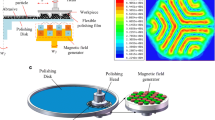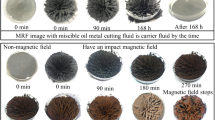Abstract
In the optical manufacturing industry, magnetorheological finishing (MRF) is widely known as a deterministic process because of its subsurface damage removal performance and high-level performance of figure correction. However, similar to other optical manufacturing methods that belong to computer-controlled polishing, MRF faces the edge effect, in which the workpiece edge is rolled up or down. As the edge effect lowers the performance of optical components, it should be improved to ensure the final performance of the optical system. In this study, the edge tool influence function (TIF) obtained when the normal TIF was suspended from the workpiece edge was analyzed, and the distortion of the TIF occurring at the edge was explained. The edge TIFs with different overhang distances and polishing parameters, such as step height of raster scan path and swipe speed of TIF, were combined to present a new mathematical model for predicting the edge effect occurring after MRF. To verify the feasibility of the proposed prediction model, the edge effect generated by the uniform polishing of the entire surface of the electroless nickel was compared and analyzed with the edge effect predicted by the proposed model. The relative error of the edge effect generated according to the polishing conditions and the edge effect predicted using the proposed model was calculated to be 4–7%, and the validity of the proposed model was experimentally verified.











Similar content being viewed by others
Abbreviations
- \(C^{\prime}_{p}\) :
-
Modified Preston constant
- \(D_{s}\) :
-
Step height
- \(\Delta\) :
-
Relative error
- \(\Delta d\) :
-
Overhang interval
- \(E_{m}\) :
-
Edge effect measured
- \(E_{p}\) :
-
Edge effect predicted
- \(H_{d}\) :
-
Deepest height of tool influence function
- \(L_{i}\) :
-
Length created by the inlet area of MR fluid
- \(L_{o}\) :
-
Length created by the outlet area of MR fluid
- \(L_{t}\) :
-
Total length of tool influence function
- \({\text{m}}\) :
-
Lateral position from the edge to the center on the workpiece
- \({\text{n}}\) :
-
Overhang distance
- \({\text{s}}\) :
-
Relative speed of the wheel and the workpiece
- \({\text{t}}\) :
-
Time
- \(T_{d}\) :
-
Dwell time
- \(\tau\) :
-
Local shear stress
- \(V_{s}\) :
-
Swipe speed
- \(W_{t}\) :
-
Total width of tool influence function
- \({\text{z}}\) :
-
Surface height
References
Schneider, F., Das, J., Kirsch, B., Linke, B., & Aurich, J. C. (2019). Sustainability in ultra precision and micro machining: A review. International Journal of Precision Engineering and Manufacturing-Green Technology, 6(3), 601–610. https://doi.org/10.1007/s40684-019-00035-2
Cook, L. M. (1990). Chemical processes in glass polishing. Journal of Non-Crystalline Solids, 120(1–3), 152–171. https://doi.org/10.1016/0022-3093(90)90200-6
Brinksmeier, E., Mutlugünes, Y., Klocke, F., Aurich, J. C., Shore, P., & Ohmori, H. (2010). Ultra-precision grinding. CIRP Annals, 59(2), 652–671. https://doi.org/10.1016/j.cirp.2010.05.001
Jourani, A., Dursapt, M., Hamdi, H., Rech, J., & Zahouani, H. (2005). Effect of the belt grinding on the surface texture: Modeling of the contact and abrasive wear. Wear, 259(7–12), 1137–1143. https://doi.org/10.1016/j.wear.2005.02.113
Schinhaerl, M., Smith, G., Stamp, R., Rascher, R., Smith, L., Pitschke, E., Sperber, P., & Geiss, A. (2008). Mathematical modelling of influence functions in computer-controlled polishing: Part I. Applied Mathematical Modelling, 32(12), 2888–2906. https://doi.org/10.1016/j.apm.2007.10.013
Kordonski, W., & Jacobs, S. (1996). MAGNETORHEOLOGICAL FINISHING. International Journal of Modern Physics B, 10, 2837–2848. https://doi.org/10.1142/S0217979296001288
Kordonski, W., & Gorodkin, S. (2011). Material removal in magnetorheological finishing of optics. Applied Optics, 50(14), 1984. https://doi.org/10.1364/AO.50.001984
Jones, R. A. (1986). Computer-controlled optical surfacing with orbital tool motion. Optical Engineering, 25(6), 256785. https://doi.org/10.1117/12.7973906
Preston, F. W. (1927). The theory and design of plate glass polishing machines. Journal of the Society of Glass Technology, 11, 214–256.
Wagner, R. E., & Shannon, R. R. (1974). Fabrication of Aspherics using a mathematical model for material removal. Applied Optics, 13(7), 1683. https://doi.org/10.1364/AO.13.001683
Luna-Aguilar, E., Cordero-Davila, A., Gonzalez, J., Nunez-Alfonso, M., Cabrera, V., Robledo-Sanchez, C. I., Cuautle-Cortez, J., & Pedrayes, M. H. (2003). Edge effects with Preston equation. Future Giant Telescopes Proceeding of SPIE. https://doi.org/10.1117/12.459869
Cordero-Dávila, A., González-García, J., Pedrayes-López, M., Aguilar-Chiu, L. A., Cuautle-Cortés, J., & Robledo-Sánchez, C. (2004). Edge effects with the Preston equation for a circular tool and workpiece. Applied Optics, 43(6), 1250. https://doi.org/10.1364/AO.43.001250
Kim, D. W., Park, W. H., Kim, S.-W., & Burge, J. H. (2009). Parametric modeling of edge effects for polishing tool influence functions. Optics Express, 17(7), 5656. https://doi.org/10.1364/OE.17.005656
Liu, H., Wu, F., Zeng, Z., Fan, B., & Wan, Y. (2014). Edge effect modeling and experiments on active lap processing. Optics Express, 22(9), 10761. https://doi.org/10.1364/OE.22.010761
Shorey, A. B. (2000). Mechanisms of Material removal in magnetorheological finishing (MRF) of glass. University of Rochester.
DeGroote, J. E., Marino, A. E., Wilson, J. P., Bishop, A. L., Lambropoulos, J. C., & Jacobs, S. D. (2007). Removal rate model for magnetorheological finishing of glass. Applied Optics, 46(32), 7927. https://doi.org/10.1364/AO.46.007927
Miao, C., Shafrir, S. N., Lambropoulos, J. C., Mici, J., & Jacobs, S. D. (2009). Shear stress in magnetorheological finishing for glasses. Applied Optics, 48(13), 2585. https://doi.org/10.1364/ao.48.002585
Kum, C. W., Sato, T., & Wan, S. (2013). Surface roughness and material removal models for magnetorheological finishing. International Journal of Abrasive Technology, 6(1), 70. https://doi.org/10.1504/IJAT.2013.053170
Hu, H., Dai, Y., Peng, X., & Wang, J. (2011). Research on reducing the edge effect in magnetorheological finishing. Applied Optics, 50(9), 1220. https://doi.org/10.1364/AO.50.001220
Zhong, X., Fan, B., & Wu, F. (2020). Reducing edge error based on further analyzing the stability of edge TIF and correcting the post-edge algorithm in MRF process. Optical Review, 27(1), 14–22. https://doi.org/10.1007/s10043-019-00555-x
Pollicove, H., & Golini, D. (2003). Deterministic manufacturing processes for precision optical surfaces. Key Engineering Materials, 238–239, 53–58. https://doi.org/10.4028/www.scientific.net/KEM.238-239.53
Bingham, R. G., Walker, D. D., Kim, D.-H., Brooks, D., Freeman, R., & Riley, D. (2000). A novel automated process for aspheric surfaces. Current Developments in Lens Design and Optical Systems Engineering Proceeding of SPIE, 4093, 6. https://doi.org/10.1117/12.405237
Kim, D. W., & Kim, S.-W. (2005). Static tool influence function for fabrication simulation of hexagonal mirror segments for extremely large telescopes. Optics Express, 13(3), 910. https://doi.org/10.1364/OPEX.13.000910
Kordonski, W., & Golini, D. (2002). Multiple application of magnetorheological effect in high precision finishing. Journal of Intelligent Material Systems and Structures, 13(7–8), 401–404. https://doi.org/10.1106/104538902026104
Shorey, A. B., Jacobs, S. D., Kordonski, W. I., & Gans, R. F. (2001). Experiments and observations regarding the mechanisms of glass removal in magnetorheological finishing. Applied Optics, 40(1), 20. https://doi.org/10.1364/AO.40.000020
Ghosh, G., Dalabehera, R. K., & Sidpara, A. (2019). Parametric study on influence function in magnetorheological finishing of single crystal silicon. International Journal of Advanced Manufacturing Technology, 100(5–8), 1043–1054. https://doi.org/10.1007/s00170-018-2330-1
Acknowledgements
This work was supported by the Korea Basic Science Institute (C230224), Materials/Parts Technology Development Program in the Ministry of Trade, Industry and Energy (PR2022059), and the Basic Science Research Program through the National Research Foundation of Korea funded by the Ministry of Science, ICT & Future Planning (NRF-2019R1F1A1050719).
Author information
Authors and Affiliations
Contributions
All authors read and approved the final manuscript.
Corresponding author
Ethics declarations
Competing interests
The authors declare that they have no competing interests.
Additional information
Publisher's Note
Springer Nature remains neutral with regard to jurisdictional claims in published maps and institutional affiliations.
Rights and permissions
Springer Nature or its licensor holds exclusive rights to this article under a publishing agreement with the author(s) or other rightsholder(s); author self-archiving of the accepted manuscript version of this article is solely governed by the terms of such publishing agreement and applicable law.
About this article
Cite this article
Jeon, M., Jeong, SK., Kang, JG. et al. Prediction Model for Edge Effects in Magnetorheological Finishing Based on Edge Tool Influence Function. Int. J. Precis. Eng. Manuf. 23, 1275–1289 (2022). https://doi.org/10.1007/s12541-022-00722-2
Received:
Revised:
Accepted:
Published:
Issue Date:
DOI: https://doi.org/10.1007/s12541-022-00722-2




